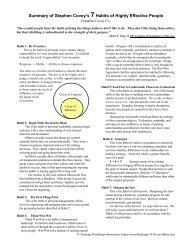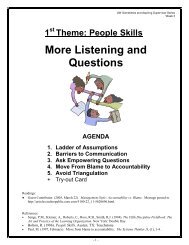Introduction to Integral Theory and Practice IOS Basic and the AQAL ...
Introduction to Integral Theory and Practice IOS Basic and the AQAL ...
Introduction to Integral Theory and Practice IOS Basic and the AQAL ...
You also want an ePaper? Increase the reach of your titles
YUMPU automatically turns print PDFs into web optimized ePapers that Google loves.
won’t talk <strong>to</strong> you”). And so on with <strong>the</strong> o<strong>the</strong>r major chakras, each of <strong>the</strong>m having a<br />
solar <strong>and</strong> lunar, or masculine <strong>and</strong> feminine dimension; nei<strong>the</strong>r is more<br />
fundamental, nei<strong>the</strong>r can be ignored.<br />
At <strong>the</strong> 7 th chakra, however, notice that <strong>the</strong> masculine <strong>and</strong> feminine serpents<br />
both disappear in<strong>to</strong> <strong>the</strong>ir ground or source. Masculine <strong>and</strong> feminine meet <strong>and</strong><br />
unite at <strong>the</strong> crown—<strong>the</strong>y literally become one. And that is what Gilligan found with<br />
her stage-4 moral development: <strong>the</strong> two voices in each person become integrated,<br />
so that <strong>the</strong>re is a paradoxical union of au<strong>to</strong>nomy <strong>and</strong> relationship, rights <strong>and</strong><br />
responsibilities, agency <strong>and</strong> communion, wisdom <strong>and</strong> compassion, justice <strong>and</strong><br />
mercy, masculine <strong>and</strong> feminine.<br />
The important point is that whenever you use <strong>IOS</strong>, you are au<strong>to</strong>matically<br />
checking any situation—in yourself, in o<strong>the</strong>rs, in an organization, in a culture—<strong>and</strong><br />
making sure that you include both <strong>the</strong> masculine <strong>and</strong> feminine types so as <strong>to</strong> be<br />
as comprehensive <strong>and</strong> inclusive as possible. If you believe that <strong>the</strong>re are no<br />
major differences between masculine <strong>and</strong> feminine—or if you are suspicious of<br />
such differences—<strong>the</strong>n that is fine, <strong>to</strong>o, <strong>and</strong> you can treat <strong>the</strong>m <strong>the</strong> same if you<br />
want. We are simply saying that, in ei<strong>the</strong>r case, make sure you <strong>to</strong>uch bases with<br />
both <strong>the</strong> masculine <strong>and</strong> feminine, however you view <strong>the</strong>m.<br />
But more than that, <strong>the</strong>re are numerous o<strong>the</strong>r “horizontal typologies” that can<br />
be very helpful when part of a comprehensive <strong>IOS</strong>, <strong>and</strong> <strong>the</strong> <strong>Integral</strong> Approach<br />
draws on any or all of those typologies as appropriate. “Types” are as important as<br />
quadrants, levels, lines, <strong>and</strong> states.<br />
Sick Boy, Sick Girl<br />
There’s an interesting thing about types. You can have healthy <strong>and</strong> unhealthy<br />
versions of <strong>the</strong>m. To say that somebody is caught in an unhealthy type is not a<br />
way <strong>to</strong> judge <strong>the</strong>m but <strong>to</strong> underst<strong>and</strong> <strong>and</strong> communicate more clearly <strong>and</strong><br />
effectively with <strong>the</strong>m.<br />
<strong>Introduction</strong> <strong>to</strong> <strong>Integral</strong> <strong>Theory</strong> <strong>and</strong> <strong>Practice</strong>. Page 18

















